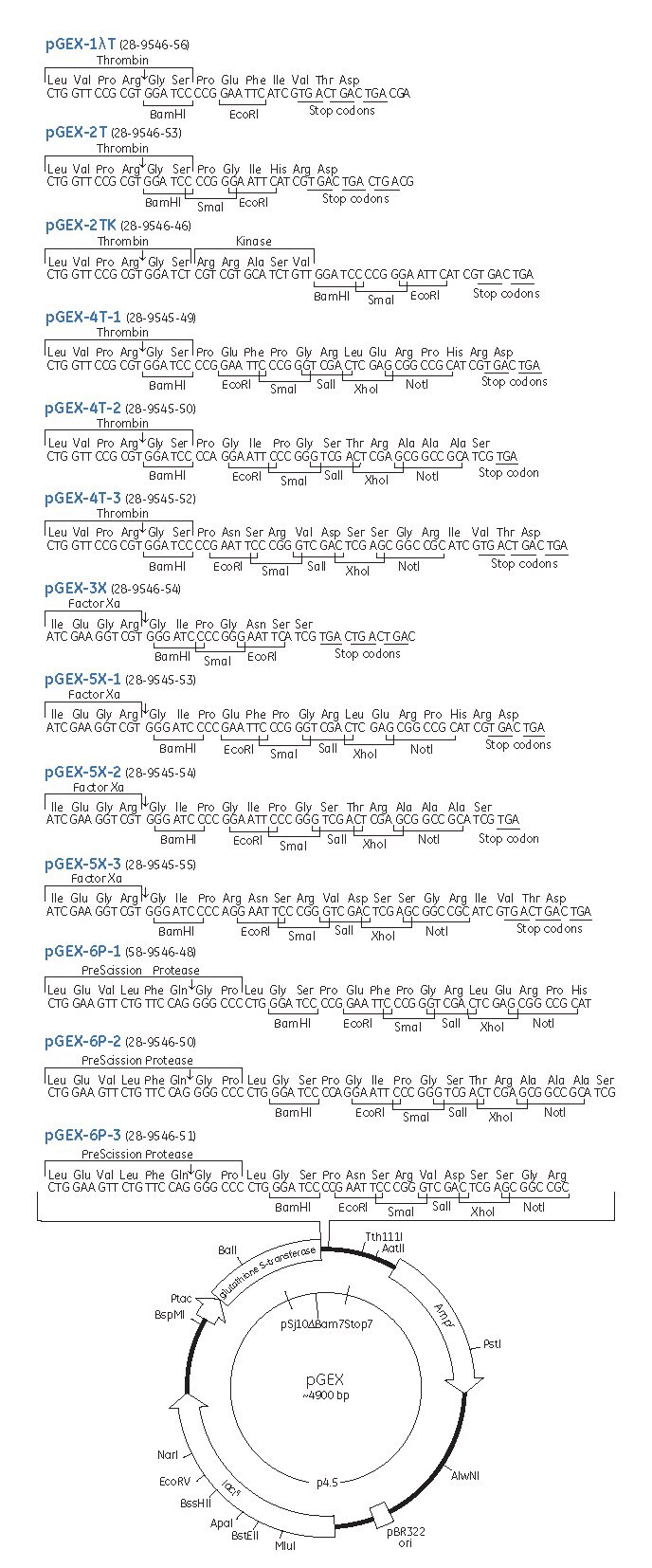pGEX Vectors
Extracted from GST Gene Fusion System, GE Healthcare, 2014
GST-tagged proteins are constructed by inserting a gene or gene fragment into the MCS of one of the 13 pGEX vectors. Expression is under the control of the tac promoter, which is induced by the lactose analog isopropyl β-D-thiogalactoside (IPTG). All pGEX vectors are also engineered with an internal lacIq gene. The lacIq gene product is a repressor protein that binds to the operator region of the tac promoter, preventing expression until induction by IPTG, thus maintaining tight control over expression of the insert.
Nine of the vectors have an expanded MCS that contains six restriction sites. The expanded MCS facilitates the unidirectional cloning of cDNA inserts obtained from libraries constructed using many available lambda vectors. pGEX-6P-1, pGEX-6P-2, and pGEX-6P-3 each encode the recognition sequence for site-specific cleavage by PreScission Protease between the GST domain and the MCS. pGEX-4T-1, pGEX-4T-2, and pGEX-4T-3 are derived from pGEX-2T and contain a thrombin recognition site. pGEX-5X-1, pGEX-5X-2, and pGEX-5X-3 are derivatives of pGEX-3X and possess a Factor Xa recognition site (Table 1.1).
pGEX-2TK has a different MCS from that of the other vectors. pGEX-2TK is designed to allow the detection of expressed proteins by directly labeling the tagged products in vitro. This vector contains the recognition sequence for the catalytic subunit of cAMP-dependent protein kinase obtained from heart muscle. The protein kinase site is located between the thrombin recognition site and the MCS. Expressed proteins can be directly labeled using protein kinase and [γ–32P]ATP and readily detected using standard radiometric or autoradiographic techniques. pGEX-2TK is a derivative of pGEX-2T, and its tagged protein can be cleaved with thrombin.
Collectively, the pGEX vectors provide all three translational reading frames beginning with the EcoRI restriction site (Figure 1.1). pGEX-1λT, pGEX-6P-1, pGEX-4T-1, and pGEX-5X-1 can directly accept and express cDNA inserts isolated from λgt11 libraries.
Refer to Appendix 2 (Control regions for pGEX vectors) for a listing of the control regions of the pGEX vectors. Complete DNA sequences and restriction site data are available from GenBank™. GenBank accession numbers are listed in Appendix 2 (Control regions for pGEX vectors).

Figure 1.1.Map of the GST vectors showing the reading frames and main features. All 13 vectors have stop codons in all three reading frames downstream from the MCS (not depicted in this map). See Appendix 2 (Control regions for pGEX vectors) for the control regions of the 13 vectors.
Select the proper vector to match the reading frame of the cloned insert.
Consider which protease and conditions for cleavage are most suitable for your target protein preparation.
pGEX-6P PreScission Protease vectors offer the most efficient method for cleavage and purification of GST-tagged proteins. Site-specific cleavage is performed with simultaneous immobilization of the protease on the column. The protease has high activity at low temperature so that all steps can be performed in the cold room to protect the integrity of the target protein. Cleavage enzyme and GST tag are removed in a single step, as described in Chapter 5.
如要继续阅读,请登录或创建帐户。
暂无帐户?